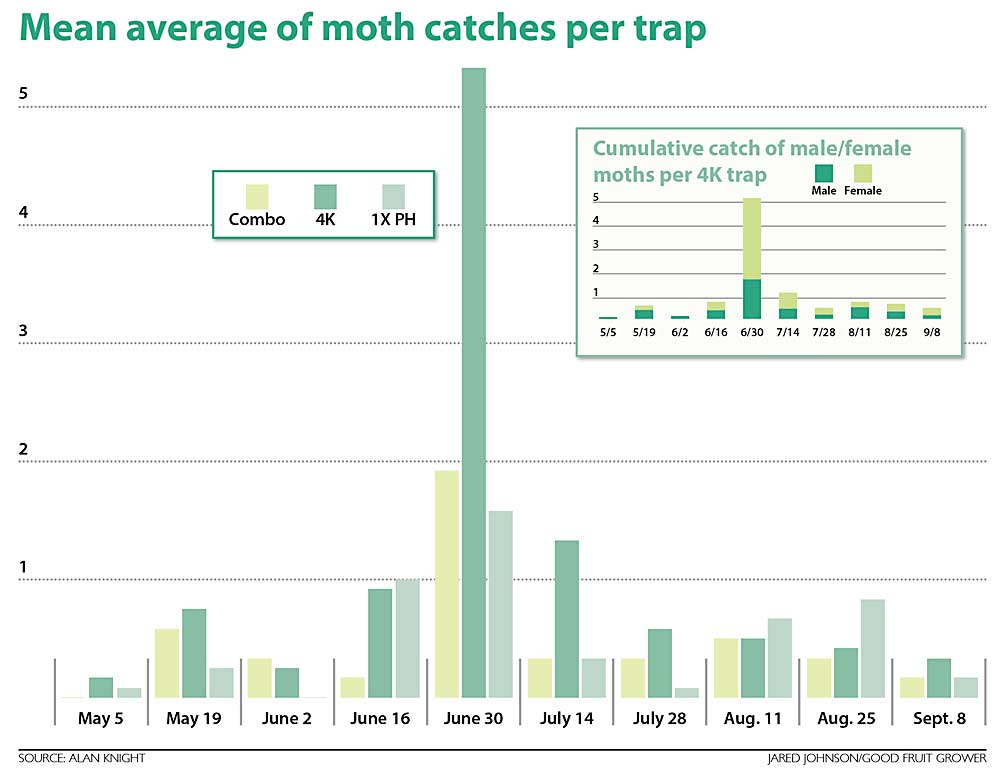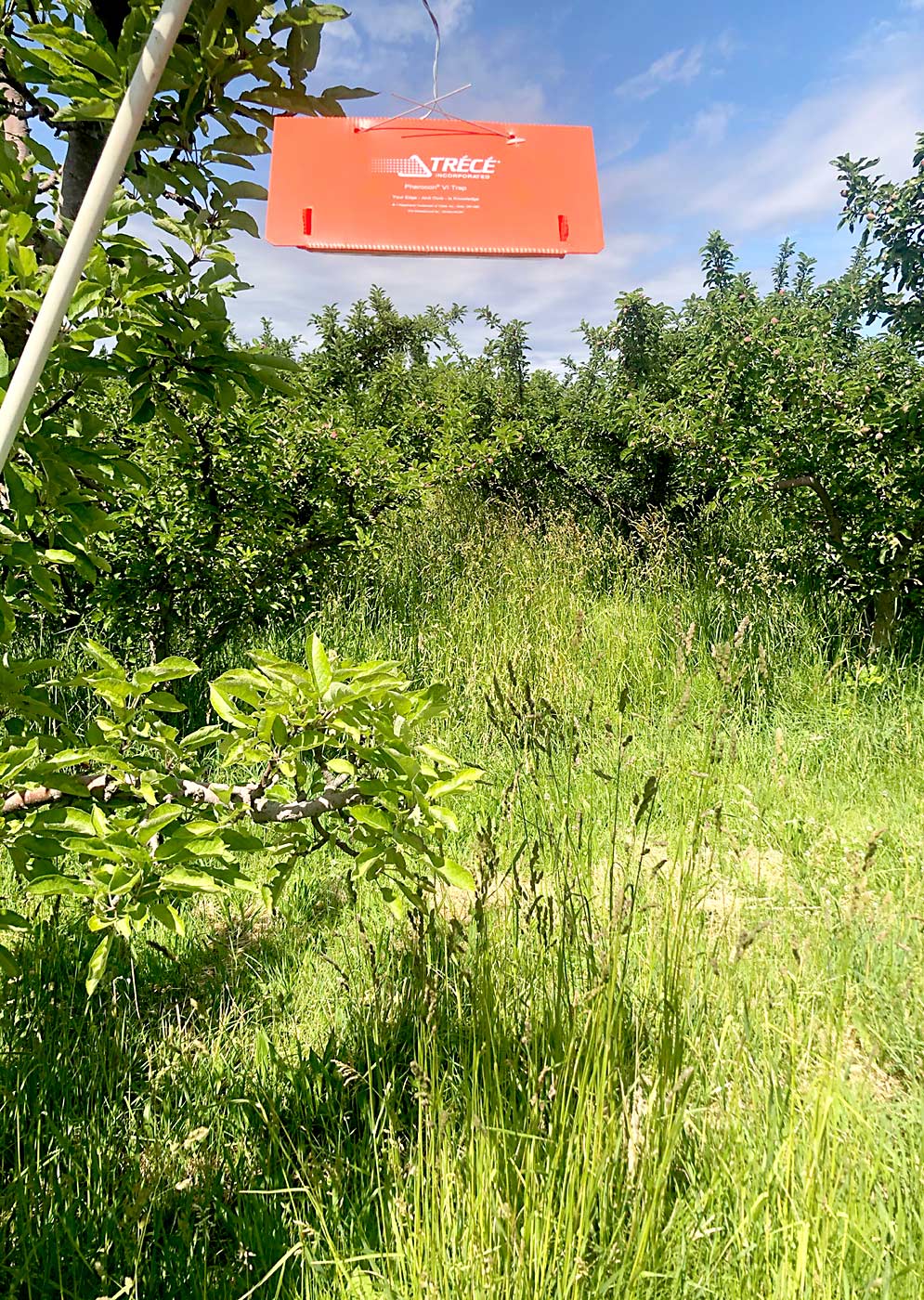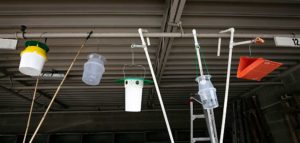
Science discoveries often arrive at the confluence of knowledge, perseverance and good luck. With advances in codling moth monitoring, it took 20 years for a group of scientists, working mostly independently but with informal collaboration and competition, to develop a powerful non-pheromone lure. This new lure is composed of three plant volatiles plus acetic acid.
Each component was suggested by a different researcher: Doug Light (U.S. Department of Agriculture-Agricultural Research Service, Albany, California) discovered pear ester, a volatile of ripe pear; Peter Landolt (USDA-ARS, Wapato, Washington) added acetic acid, a microbial volatile produced in fermenting fruit; Alan Knight (USDA-ARS, Wapato) combined these with nonatriene, a ubiquitous volatile released from damaged plant tissue; and, finally, Marco Tasin from Swedish University (Alnarp, Sweden) suggested linalool oxide, a compound he was studying in grape, as the fourth component of what’s now known as the 4K lure. In 2018, along with visiting international colleagues from Italy, Uruguay and Chile, I put them all together in a series of studies. The blend has now been commercialized as the Pherocon MegaLure 4K by Trécé Inc., the Oklahoma-based pheromone-product manufacturer.
Research in recent years, funded in part by the Washington Tree Fruit Research Commission, shows that traps baited with 4K can serve several roles to support growers’ management programs. First, the non-pheromone lure catches more moths than the best sex pheromone-based lure. Second, the lure works similarly in orchards treated with or without mating disruption. Third, the lure attracts both sexes of moths and provides a seasonal picture of moth density and sex ratios in the orchard. Fourth, the lure is long-lasting (over eight weeks). Fifth, the lure does not pull moths into the orchard and provides a better correlation with local pest pressure. Sixth, the lure can be used to significantly reduce fruit injury through female removal. Seventh, dissections of female moths can provide useful information on the mating status of moths inside orchards.
Of course, nothing is perfect, and we learned in 2021 that moth catch in traps baited with the 4K lure can be influenced by an orchard’s weed management program. For example, in organic blocks where no herbicides are used and weeds in the tree row are allowed to grow all season, except for limited mowing around sprinklers, moth catch with the 4K lure was reduced relative to the Combo lure with acetic acid. This is likely due to the influence of various weed volatiles, including nonatriene, disrupting moth orientation into a trap. Studies planned for 2022 will survey the potential impact of variable weed management programs used by growers on the relative performance of the 4K and other lures.
Since weeds are typically managed in conventional orchards and the 4K lure is not impacted by mating disruption, we will explore using the 4K lure to create a useful index for growers to assess the effectiveness of mating disruption programs. This index (CM-EMD) is the ratio of male moth catch in traps baited with the standard 1X red septa sex pheromone lure divided by male catch with the 4K lure. Growers would be able to use paired traps in different blocks to establish how well their mating disruption programs are performing.

The second use for the 4K lure is to protect orchards in combination with mating disruption via female removal. For example: Over the past two seasons, an array of 55 4K-baited traps placed in the southwest corner of a conventional apple block was used to remove about 15,000 codling moth adults (8,000 females, 80 percent mated) flying out of an abandoned orchard situated some 300 yards from the trapped orchard. Unfortunately, using this approach with the 4K lure in organic blocks, which often suffer much greater problems with codling moth, cannot be used until all four volatiles are registered as organic.
A third use for the 4K lure is created by our new ability to collect samples of female codling moths for dissections to determine their mating status and determine how well mating disruption and sterile insect release (SIR) programs are performing. During 2021, we used the lure to monitor 48 orchards under mating disruption, and the proportion of female moths that were mated ranged from zero to 100 percent across orchards. These data provided two preliminary but useful insights into these management strategies.
First, SIR did not appreciably increase mating of wild females, as would be expected from weekly releases of 400 sterile males per acre in the first flight when compared with similar blocks without the added males: 66 percent mated versus 60 percent, respectively. However, mating levels of wild females were quite high in July and August with SIR compared with similar blocks without SIR: 82 percent versus 57 percent. This is interesting, but the most direct analysis of the efficacy of SIR could be accomplished in the future with live trapping of female moths to allow eggs to be characterized as fertile or sterile.
Second, we were surprised to find levels of mating were significantly lower in blocks that received both sex pheromone dispensers and aerosols, compared to blocks with aerosols alone. In the first flight, we found 9 percent mated females versus 35 percent and in the second and third flights, 31 percent compared to 50 percent. Although we don’t fully understand this finding, these data suggest that current uses of mating disruption can likely be improved. Studies planned for 2022 will compare both the aforementioned CM-EMD index and the mating success under mating disruption programs based on variable densities of different hand-applied dispensers, aerosol units and sprayables.
Finally, the dissections of female codling moths caught with the 4K lure allowed us to categorize orchards into several groups based on the importance of moth immigration. These data suggest that for orchards dealing with high levels of females flying in from nearby hosts or abandoned orchards, the use of mating disruption or SIR could at best be marginally effective. It appears that only a well-timed spray program can protect these types of orchards and/or the use of exclusion netting. Moreover, orchards can most effectively be protected from codling moth if they are essentially under areawide protection provided by their own effective programs and surrounded by neighbors with clean orchards.
It is unfortunate that the 4K lure was not available during the areawide programs developed in the 1990s to more completely evaluate the success of growers working together to combat codling moth, but orchard managers today may find that the 4K lure can serve an important role for them moving forward.
—by Alan Knight
Alan Knight is the president of Instar Biologicals and a Yakima-based entomologist who retired in 2019 after a career with the U.S. Department of Agriculture’s Agricultural Research Service.







Leave A Comment